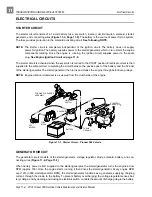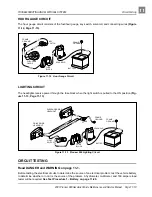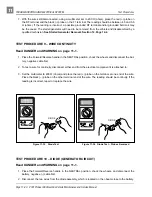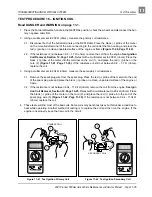
TROUBLESHOOTING AND ELECTRICAL SYSTEM
Test Procedures
2001 Pioneer 900 Gasoline Vehicle Maintenance and Service Manual Page 11-21
11
1. Place the Forward/Reverse handle in the NEUTRAL position, and chock the wheels.
2. Check for loose or corroded battery terminal connections. Clean, tighten, and replace connections as
necessary.
Hydrometer Test
A hydrometer (CCI 1011478) measures the specific gravity. The higher the specific gravity, the higher the
state of charge of the battery. A fully charged battery should read between 1.250 and 1.280 at 80 °F (27 °C).
Never add acid to the battery to obtain a higher specific gravity (Figure 11-22, Page 11-22).
∆ CAUTION
• Do not allow battery acid from battery caps or hydrometer to drip onto the body. Battery acid will
cause permanent damage. Wash off immediately.
Performing the Hydrometer Test
1. Be sure that the battery has sufficient water to cover the plates by approximately 0.5 inch (12.7 mm)
and is fully charged prior to beginning the test. If water must be added, recharge the battery before per-
forming the hydrometer test (Figure 11-23, Page 11-22).
2. Remove the vent cap.
3. Using a battery thermometer (CCI 1011767), record the electrolyte temperature of a center cell.
4. Squeeze the rubber bulb of the hydrometer and insert into the cell. Slowly release the bulb, drawing
electrolyte up into the glass tube of the hydrometer.
5. When the float rises off the bottom, adjust the electrolyte level so that the float rides free of the bottom
but does not strike the bottom of the rubber bulb. Remove the hydrometer from the cell and release the
pressure from the bulb.
6. Hold the hydrometer vertically, ensuring that the float is not contacting the sides of the glass tube. Hold
the hydrometer at eye level and read the scale at the level of electrolyte (Figure 11-22, Page 11-22).
7. Record the reading.
8. Return the electrolyte to the cell from which it was taken. Replace vent cap.
9. Repeat steps 2 through 8 on all cells.
Hydrometer Calibration
Most hydrometers are calibrated to read correctly at 80 °F (27 °C). The readings obtained as described
above must be corrected for temperature. For each 10 °F (5.6 °C) above 80 °F (27 °C), add 0.004 to the
reading. For each 10 °F (5.6 °C) below 80 °F (27 °C), subtract 0.004 from the reading.
































